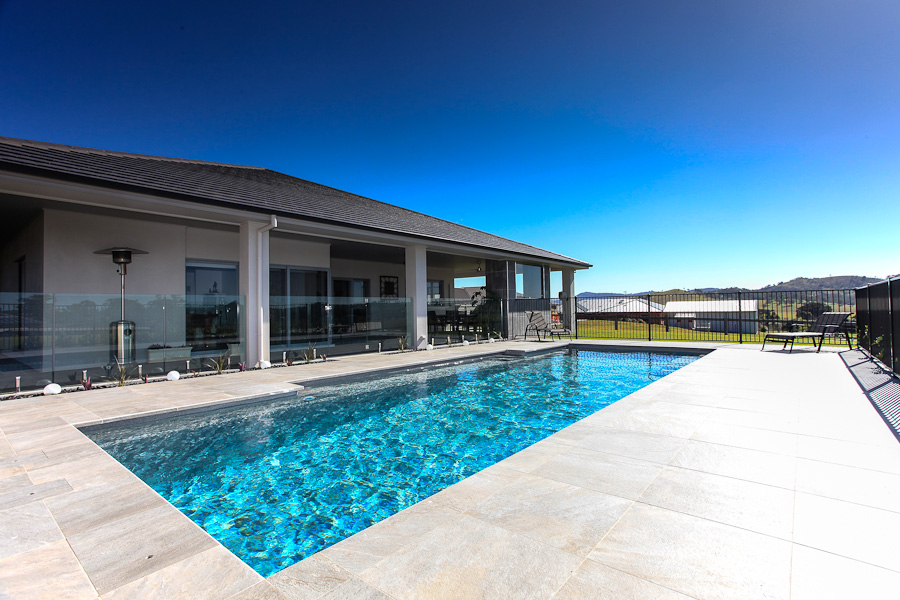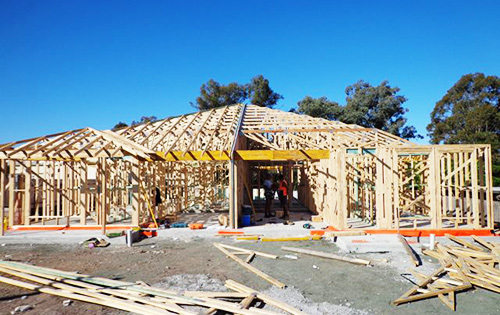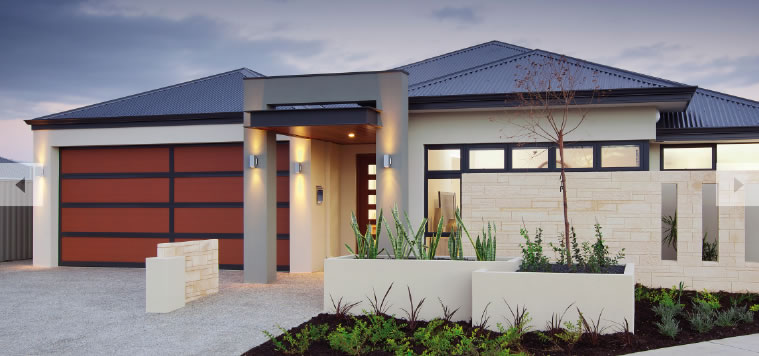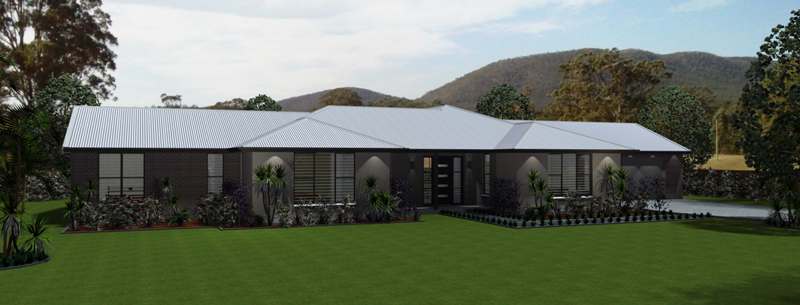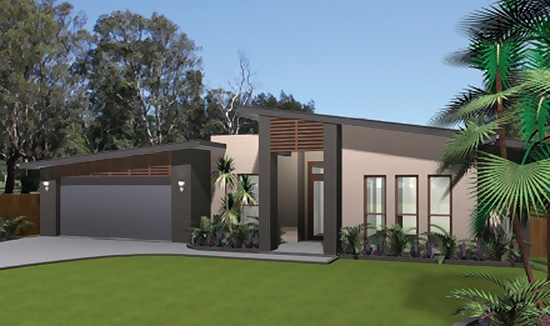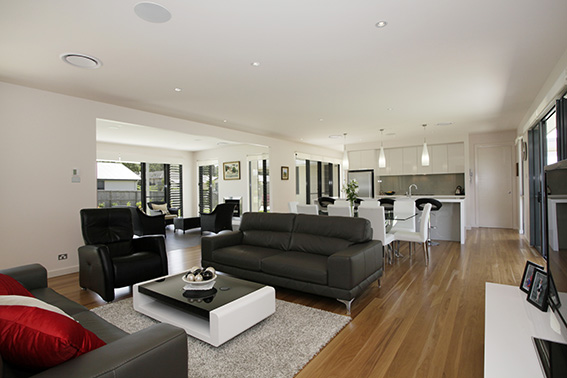STEP INTO YOUR DREAM HOME WITH CUSTOM DESIGN
Custom design is a sound investment if you’re interested in making the most out of your site. It can help you embrace environmental features, improve energy efficiency or simply give your home the extra room or two you need while nestling perfectly into your surrounding landscape. However, many people looking to build a new home assume that once you start to talk ‘customisation’ you are looking at a considerably larger investment. But that is not necessarily so…
Here are 6 simpe steps on how custom home design works:
Step 1. Write a list of everything you want your new home to include. Outline the number of bedrooms and think about the types of living areas you prefer, e.g., open plan. Do you need a study, an ensuite with a luxurious bath or maybe an indoor/outdoor entertaining area? Don’t limit yourself here. This is your opportunity to put your property dreams down on paper. You can address site restrictions, layout practicalities and your budget with our Custom Design Team at a later stage.
Step 2. As part of our Custom Design Service our team will help you browse our comprehensive range of house plans to find the design that best suits your site, budget and property requirements. You may find more than one that satisfies your needs or you may even want to combine elements from a couple of plans.
Step 3. Get creative with our team to design a plan that accommodates your list from Step 1. If you have an architect you are already working with we can help facilitate that relationship also. By using existing plans your investment is streamlined to minimise any extra costs that result from designing a home from scratch.
Step 4. With your customised house plans complete now it’s time to select finishes and fixtures. For many this step can be one of the most daunting due to the overwhelming amount of products on the market. To simplify this we have trusted suppliers you can talk to about the best, quality solutions for your home.
Step 5. You made it – all of the design decisions have been made. It’s time to relax and let Valley Homes take care of your new development including the entire building process.
Step 6. Whether it’s a tranquil retreat or an entertainer’s paradise, simply enjoy the lifestyle you have always wanted in your brand new custom designed home!
Need some custom design inspiration?
Over the past 40 years Valley Homes has worked with Newcastle, Maitland and Hunter Valley families who have been blown-away by their finished design – and the possibilities are endless. Here are some custom design features that recently delighted an Aberglasslyn family:
Our full gallery also includes more inspirational builds and for more information please read our Custom Design Service page or talk to our team.
CHOOSING THE RIGHT BUILDER FOR YOUR HOME OR INVESTMENT
Finding the right builder is key to the success of your home or investment construction project in Maitland and the Hunter area. It’s worth doing your research on the company and the builder that you are planning to hire. Deciding who should build your home is an important decision. Making the wrong choice could see your construction project suffer in delays, costs and stress. Here are some top questions to ask to guide you and make the right decision when choosing a builder.
- How long has the builder been operating?
Ask the builders that you are planning to hire some simple questions such as;
- How long have they been in the construction business?
- If the builder owns the company? Perform the necessary checks with the relevant authorities.
These simple questions and performing background checks will paint a better picture of the construction professional you’re looking to hire.
- Does the company have a permanent business address?
Find out the exact location of the building company’s office and take the time to visit it to get an impression of how professional their business is. It’s also important to know their location if you ever need to drop in during the construction process. A verified trading and registered office address also tends to reflect a company that is more reputable.
- Have you read any client testimonials?
Experiences of other customers are always a great reference point for making your decision. If possible, ask your builder to put you in touch with two past clients and ideally see them and their project for yourself. When you talk to the clients extract as much information as possible and ask them about their experiences with the builder.
- Are you getting a detailed quotation?
A good indication of how reputable a builder is can be discovered by the kind of quotation that they provide. A thorough and detailed construction estimate means that every small detail is accounted for and provides complete transparency. Quotations that are quick, short and lacking in detail could mean that the builder is inexperienced or less reputable.
- Are you getting everything in writing?
Remember, you should only proceed with your home or investment construction project when the price is fixed and you get a well-written contract from your builder. Get all details about the build in writing. This will help you for future reference with issues that might arise during construction.
Follow these tips to guide your decision with which builder to appoint for your property or investment project in the Maitland and the Hunter area.
3 TIPS FOR BUILDING AN ENERGY EFFICIENT HOME
With rising energy bills it is becoming increasingly important that your home is built with energy efficiency in mind. Not only is this good for your wallet but it’s also great for the environment. Even if you are not buying or building a new house you can take steps to make an older house more energy efficient.
Energy prices have risen significantly over the past few decades. Government regulation mean that many new houses in Australia must meet tough energy efficient guidelines such as double glazing, insulated roofing and the amount of glass that can be used per square metre.
However an older property built before the 1990’s might not be as efficient as energy conservation was a not a major deciding factor in the building of these properties.
3 energy efficiency tips when building a new house or improving your current home:
- Install adequate insulation
Inadequate insulation is the main reason for energy wastage, especially in older buildings. Most home owners spend a significant amount of their hard earned dollars on cooling and heating their homes to compensate for this.
Here’s a handy checklist that might indicate whether your home is sufficiently insulated or not:
- High energy bills
- Excessive drafts
- Home is very cold in the Winter and excessively hot in Summer
- Excessive noise from outdoors (insulation stops sound)
If your home falls under two or more of the above criteria then you should investigate whether your home is insulated properly. It’s highly recommended that you hire a professional to help solve the problem.
- Select exterior colours and finishes wisely
You may find it hard to believe but you can cut down your energy bills and improve energy efficiency by applying the appropriate paint on your home’s interior & exterior walls. A light coloured roof plays a vital role in conserving energy in your home. Especially with the arid climate in Australia, homes can become extremely hot in summer so a light coloured roof can lower cooling costs significantly. High quality paints deflect extreme light and heat, preventing it from entering your property in the first place.
- Ensure your home is well ventilated
Ventilators, fans, whirly birds and well-positioned door and window openings not only provide fresh air but also exhaust stale air from the home. Poor ventilation can result in unwanted condensation on windows or cause surfaces to become mouldy. Allowing airflow through the building is enough create a cooling effect on a warm day.
HOW TO BUILD YOUR DREAM ACREAGE HOME
A prime piece of acreage is a blank canvas for any residential home builder. A dream home can be tailored to the individual needs and desires of the resident. Landowners intent on building a dream home using acreage property face an exciting range of possibilities as well as a number of challenges, but the path becomes much simpler with a defined and reliable process. Valley Homes offer an exceptional one-on-one service every step of the way from initial discussions through to stepping over the threshold of your new home.
Set a Budget
The most important part of building a dream home is to set a budget well in advance of the planning stages. A hard cap on expenses helps builders make more efficient decisions about resources and lessens the chance of a design suddenly becoming too ambitious. Wants and needs should be evaluated carefully against the total to minimise unnecessary costs.
Develop a plan
Building on acreage requires Development Approval from the local council and this requires a comprehensive building proposal. The application is evaluated for its total impact on the surrounding area and even a minor issue or oversight could mean the denial of a proposal. For this reason it is beneficial to have an application prepared by a professional builder like Valley Homes.
Be prepared to compromise
Local building codes can occasionally create restrictions on the designs of a dream home. There are a multitude of factors that go into a home’s suitability for construction from technical issues such as drainage to aesthetic concerns about the size and layout of a home. Any concerns raised must be addressed in the finalised plans in order to receive approval and for most landowners, it is better to sacrifice small elements of the ultimate dream home design to ensure it can become anything more than a dream.
Stick to your budget
It cannot be emphasised enough how surprisingly easy it is for home construction to rapidly spiral out of control without a professional to guide you - beware of hidden expenses.
Planning and building a dream home can quickly become a nightmare without the proper plans in place. Valley Homes will take care of the building process from start to finish.
Most important when planning a dream home is to consider its long-term potential. The best home designs in the Hunter Valley not only fulfill all of their resident’s current needs but grow with them to respond to changes in their lives and lifestyles. Careful consideration, meticulous planning and well-advised action are essential components for building your dream acreage home.
For more information see:
• Valley Homes Acreage Series designs
• NEWS: Introducing the new Acreage Series
HOW TO FINANCE BUILDING A HOME
Building a property can be an attractive proposition in that it allows the purchaser to obtain the home they want whilst adhering to the budget they have available. It’s important to note that home building budgets need to be carefully planned to include any required land acquisition costs as well as the building process itself.
In New South Wales there are certain grants available both for first home owners and for new home construction. Construction loans are tailored to those purchasers who are building a home and can help meet any remaining purchase cost. Financing needs to be in place before the purchaser enlists the services of any construction professional such as a home builder in Maitland.
What is a first home owner grant?
Available for the purchase of brand new homes only, including the building of a new home, these grants are available to adult permanent residents or Australian citizens who have not had a relevant interest or investment in a residential property prior to 1 July 2000. Purchasers who have had a relevant investment in a property since 1 July 2000 may qualify, if they have not resided in the property for a continuous period of six months.
Availability of the grants is to individuals only, not companies or trusts, and is subject to a strict list of criteria. Purchasers can obtain details of these grants from their financial institution. They can also apply by approaching the New South Wales Office of State Revenue, but only after the home construction is complete and the title is signed over.
Currently the amount of the first home owner grant is $15,000, but the amount is scheduled to reduce to $10,000 on 1 January 2016.
What is a new home construction grant?
Instigated on 1 July 2012, the new home construction grant is available for purchasers of a newly constructed home, an off the plan home or a plot of land with the intention of building a home. If the purchase is of a plot of land then building of the residence must commence within 26 weeks after purchase of the land purchase.
The new home construction grant is for residential property only. Unlike the first home owner grant it is available to trusts, companies and investors as well as individual prospective home owners. Applicants for the grant must be an Australian citizen or resident, or an Australian owned body and any award is subject to the applicant satisfying a list of conditions. A full list of these conditions is available from the New South Wales Office of State Revenue, to whom applications should also be made.
The amount awarded as a new home construction grant is $5,000 which is allocated to the payment of any duty due on the purchase.
What are the benefits of a construction loan?
Whether or not there is any entitlement to a grant, a purchaser needs to secure funding for any remaining costs. This finance needs to be in place before land is purchased and any professionals, such as builders in Maitland, start work.
A construction loan is specifically formulated for use by those people starting from scratch with the building of a home. It allows for the drawing down of finance at specific stages during the building process. This means that the purchaser only pays interest on the amount of the loan that has actually been used. It’s a good solution to the financing of building a new property. On completion of the build the purchaser is then given the option of which home loan product the construction loan is converted to.
THE ENERGY EFFICIENT HOME
Energy efficient homes are designed to reduce energy consumption for heating, cooling and lighting purposes. The following ways can help you to improve energy efficiency.
1. Bioclimatic design:
This type of construction considers the local micro climate and site features to help achieve indoor comfort. By considering the local environment the design uses low or ‘no’ energy solutions for a comfortable home environment.
Bioclimatic design includes the following principles:
- Compact building footprint to minimise surface area in direct contact with the environment .
- Orientation combined with well positioned windows & doors to provide cross ventilation and to control solar access. Interior spaces positioned depending on their heating/cooling/lighting requirements for time of day and season.
- Treatment of the external building envelope and openings to protect the structure from extreme solar heat. Solar radiation is collected by passive solar systems that act as “free” lighting and heating systems.
2. Thermal insulation:
Effectively installed insulation works to ensure energy efficiency in all elements of the home including walls, roofs, lofts, ground decks and facades.
Insulation is just as important in hot regions as it is in colder climates. In warmer areas the system keeps the heat out, minimising the use of air conditioning whereas in cold areas it keeps the heat in, limiting the use of energy for heating.
3, Air tightness:
To create comfortable, controllable energy efficient homes, air leakages should be reduced as much as possible. Air tightness has become a widely discussed and an increasingly important issue, with stricter building regulations coming into effect that require greater energy efficiency.
4. Ventilation:
Defined as controlled or intended ingress and egress of air through homes. Ventilators and well positioned door and window openings not only provide fresh air but also exhaust stale air from the home. Neglecting insulation or ventilation can result in warm, humid air condensing on poorly insulated or cold surfaces causing mould growth. Allowing air flow through the building also in itself provides a cooling effect on a warm day.


